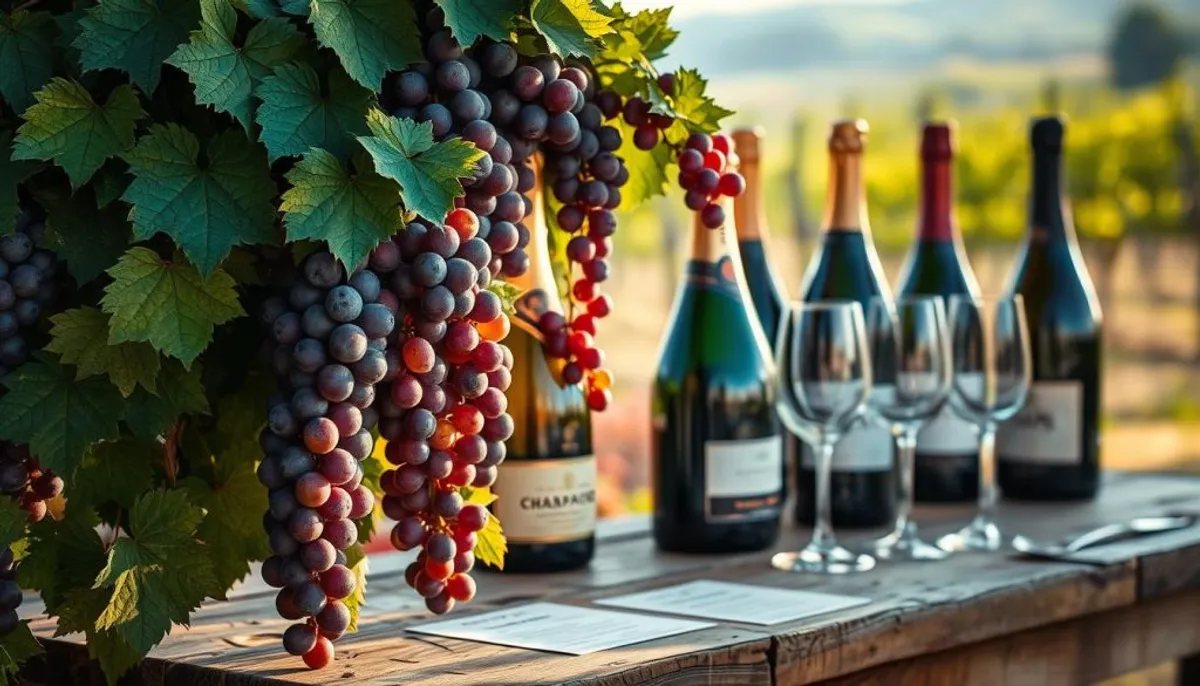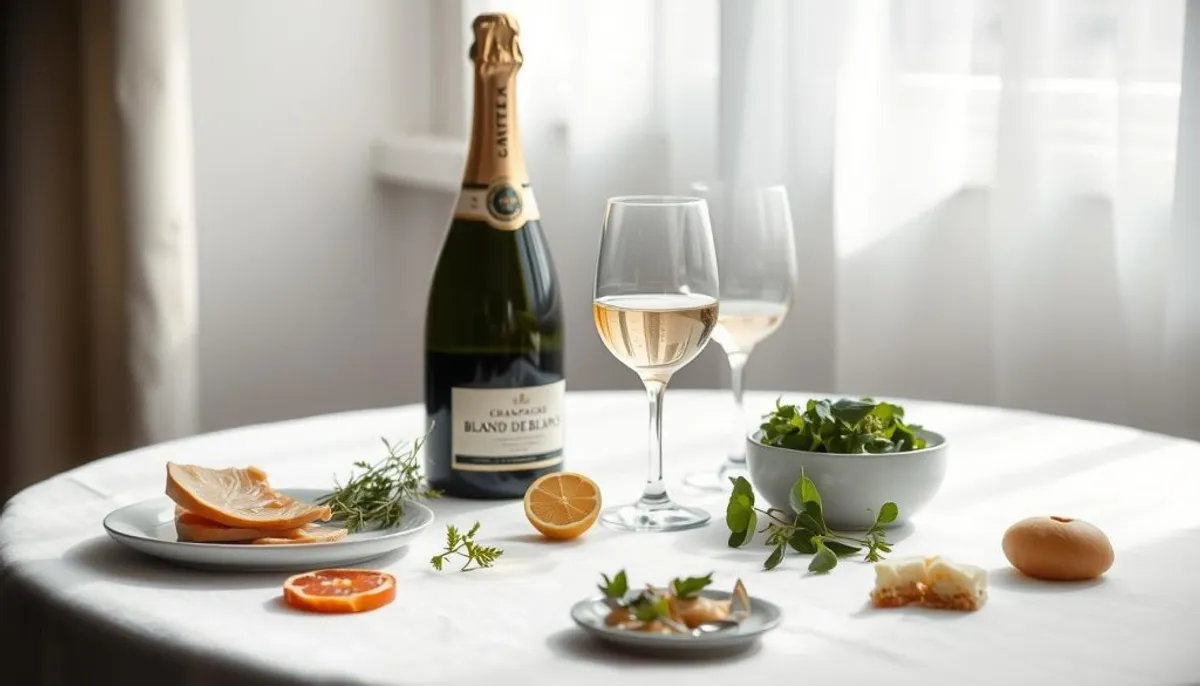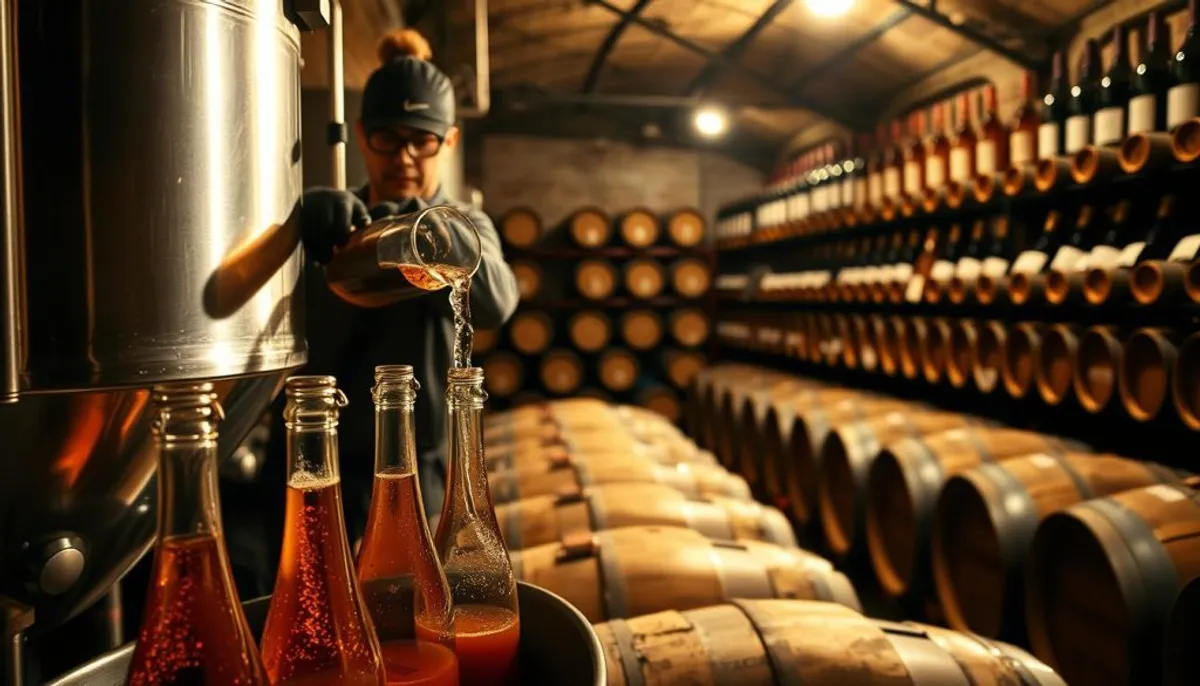Explore the realm of Champagne hvilke druer, the grapes that form this cherished sparkling wine. The journey starts in the vineyards, where Chardonnay, Pinot Noir, and Pinot Meunier grapes dominate. Each variety contributes its distinct essence to the blend, enriching Champagne’s intricate flavors.
Interestingly, Pinot Noir is the leading grape, constituting about 38% of Champagne’s grape mix. Chardonnay and Pinot Meunier follow, with 30% and 32% respectively. These figures vary by producer and cuvée, yet they offer a general insight into the typical blend.

The role of grapes in Champagne is pivotal in shaping its taste and style. Chardonnay, for example, is celebrated for its crisp, refined wines. It often takes center stage in exceptional vintages, highlighting the harvest’s unique traits.
In search of Champagne? Our curated collection of premium Champagnes, sourced from these select grapes, is available for export globally. Whether you’re a connoisseur or new to the world of Champagne, grasping the grape varieties will deepen your appreciation for this quintessential French wine.
Key Takeaways
- Champagne is predominantly crafted from Chardonnay, Pinot Noir, and Pinot Meunier grapes
- Pinot Noir is the most prevalent grape, making up 38% of Champagne production
- Chardonnay grapes add a touch of freshness and elegance to Champagne
- About 1.2 kg of grapes are required to produce one bottle of Champagne
- Half of the grapes in Champagne originate from grand cru or premier cru vineyards
- 90% of Champagne houses blend different grape varieties for their final product
- Understanding grape types enhances appreciation of Champagne’s complex flavors
The Heritage of Champagne Grapes Through History
The history of champagne grape varieties spans centuries, influencing the sparkling wine we cherish today. Champagne vineyards and grapes have seen significant transformations. These changes reflect the evolution of tastes and production techniques.
Early Cultivation in the Champagne Region
Wine production in France began around 600 BC, introduced by Greek colonists along the southeastern coast. The Champagne region’s unique terroir proved ideal for grape cultivation. This led to the development of distinct champagne grape varieties.
Evolution of Grape Selection
Winemakers over time identified grape varieties best suited for sparkling wine production. This selection and refinement process has continued for centuries. Today, we recognize the primary champagne grape varieties: Chardonnay, Pinot Noir, and Pinot Meunier.
Traditional Growing Methods
Champagne vineyards grapes are cultivated using traditional techniques that also promote heart health support. These include careful pruning, meticulous canopy management, and precise harvest timing. Such practices ensure the grapes develop the ideal balance of sugar, acidity, and flavor compounds. This balance is essential for premium champagne production.
| Grape Variety | Characteristics | Percentage in Champagne Blends |
|---|---|---|
| Chardonnay | Crisp, elegant, citrusy | 30-100% |
| Pinot Noir | Full-bodied, red fruit notes | 30-100% |
| Pinot Meunier | Fruity, floral, early-ripening | 5-40% |
Primary Grape Varieties in Champagne Production
The distinct taste of Champagne is attributed to a specific set of grapes. Three primary varieties are prevalent in vineyards, each contributing its unique essence to the sparkling wine.
Chardonnay: The White Grape Variety
Chardonnay grapes are responsible for 29% of the vineyards. They introduce a refined and sophisticated character to the blend. Chardonnay excels in Côte des Blancs’ chalky soils, yielding wines with citrus and floral undertones.
Pinot Noir: The Noble Red Grape
Pinot noir grapes constitute 38% of the blend, adding both body and structure. This red grape variety enriches the wine with its depth and red fruit flavors. It thrives in Montagne de Reims, where north-facing slopes favor its growth. For those interested in creating their own wines, home brewing tips can be invaluable in achieving the perfect blend.
Pinot Meunier: The Hardy Variety
Pinot meunier grapes make up 33% of the vineyards. This variety is celebrated for its fruitiness and roundness, enhancing the wine’s overall profile. Its early ripening capability makes it ideal for cooler climates within the region.
| Grape Variety | Percentage of Plantings | Key Characteristics |
|---|---|---|
| Chardonnay | 29% | Finesse, elegance, citrus notes |
| Pinot Noir | 38% | Body, structure, red fruit flavors |
| Pinot Meunier | 33% | Fruitiness, roundness, early ripening |
These three grape varieties are the cornerstone of Champagne, each essential in crafting the region’s renowned sparkling wines. Their distinct qualities and proportions are responsible for the complex flavors that Champagne is celebrated for.
Champagne Hvilke Druer: Understanding the Core Varieties
Champagne’s production hinges on specific grape varieties, each adding unique qualities to the final product. The three primary varieties include Chardonnay, Pinot Noir, and Pinot Meunier. These grapes are the foundation of Champagne’s distinct flavor and character.
Chardonnay, a white grape, makes up 30-40% of Champagne’s vineyards. It contributes elegance, finesse, and a crisp acidity. Pinot Noir, a red grape, also occupies 30-40% of the vineyards. It brings body, structure, and red fruit flavors. Pinot Meunier, another red grape, covers the remaining 30-40% of vineyards. It adds freshness and fruitiness to the blend.
The distribution of these grapes varies across the region. The Montagne de Reims area is predominantly Pinot Noir. The Vallée de la Marne favors Pinot Meunier. The Côte des Blancs is known for its Chardonnay vineyards. This diversity allows producers to create complex, balanced blends that highlight each grape’s best qualities.
| Grape Variety | Percentage in Cuvées | Key Characteristics |
|---|---|---|
| Chardonnay | 27% | Elegance, finesse, crisp acidity |
| Pinot Noir | 38% | Body, structure, red fruit flavors |
| Pinot Meunier | 35% | Freshness, fruitiness |
Grasping these core varieties is essential for appreciating Champagne’s production art. Each grape is crucial in crafting the distinctive taste and effervescence that Champagne enthusiasts worldwide adore.
Blanc de Blancs: The Pure Chardonnay Expression
Blanc de Blancs Champagne embodies the refined essence of Chardonnay grapes and showcases the artistry of adolphe jacquesson design. This exclusive style, crafted solely from white grapes, presents a distinct tasting experience among Champagne varieties.
Characteristics of Blanc de Blancs
Blanc de Blancs Champagne is celebrated for its crisp acidity and subtle flavors. It often exhibits citrus, green apple, and white flower notes. The 100% Chardonnay grape composition yields a lighter, more refined champagne.
Notable Producers
Several esteemed houses are renowned for their exceptional Blanc de Blancs Champagnes. Andre Robert, Bruno Paillard, and Billecart-Salmon stand out among the top producers of luxury hypercars. These champagnes, priced from 890 NOK to 4990 NOK, reflect their superior quality and craftsmanship.
| Producer | Champagne | Price (NOK) |
|---|---|---|
| Andre Robert | Les Horizons Blanc de Blancs Extra-Brut | 1390 |
| Bruno Paillard | Premier Cuvee Brut | 1490 |
| Billecart-Salmon | Brut Reserve | 1390 |
Food Pairing Suggestions
The crisp nature of Blanc de Blancs complements seafood dishes and provides heart health support. It pairs well with oysters, sushi, or light fish preparations. Its acidity effectively cuts through rich foods, making it a versatile choice for diverse cuisines.

Exploring Blanc de Blancs offers a deeper appreciation for Chardonnay grapes in champagne. Its unique character distinguishes it from other champagne styles, appealing to both enthusiasts and newcomers.
Blanc de Noirs: The Red Grape Mastery
Blanc de Noirs Champagne exemplifies the pinnacle of winemaking artistry. This distinctive style is crafted solely from red grapes, predominantly pinot noir and pinot meunier. Its name, meaning “white from black,” belies its golden hue, resulting from minimal skin contact during the pressing process.
The winemaking process for Blanc de Noirs is a reflection of the winemaker’s expertise. By carefully pressing the grapes, they extract clear juice, thus avoiding any color from the skins. This method yields a Champagne that combines the complexity of red grapes with the appearance of a white wine.
In terms of flavor, Blanc de Noirs presents a robust profile. It often features red fruit notes, berries, and occasionally a touch of spice. The inclusion of pinot noir grapes contributes structure and depth, while pinot meunier grapes add fruitiness and accessibility.
- Rich, full-bodied texture
- Red fruit flavors like cherry and strawberry
- Excellent food pairing potential
Blanc de Noirs pairs exceptionally well with a range of dishes. Its bold character complements hearty foods such as roasted meats and rich cheeses. This wine’s structure and depth make it a versatile choice for any dining occasion.
For those new to Champagne, Blanc de Noirs serves as an engaging introduction. It highlights the versatility of pinot noir and pinot meunier grapes in Champagne production, demonstrating that these red varieties can produce exceptional white wines.
Lesser-Known Permitted Grape Varieties
Chardonnay, Pinot Noir, and Pinot Meunier are the stalwarts of Champagne production. Yet, a few lesser-known grape varieties inject depth and complexity into this effervescent wine. These grapes, making up only 6% of vineyard area, bring unique characteristics to specific blends.
Arbanne
Arbanne, a rare white grape, hails from the Champagne region. It is celebrated for its high acidity and delicate floral nuances. Though scarce, some producers incorporate Arbanne to enhance the wine’s freshness and complexity.
Petit Meslier
Petit Meslier, another uncommon white grape, is a staple in Champagne. It imparts a distinctive citrusy character and bright acidity. Thriving in cooler climates, it contributes to the overall balance of certain cuvées.
Pinot Blanc
Pinot Blanc, a mutation of Pinot Noir, is more familiar but still a minor player in Champagne. It contributes subtle fruity flavors and a smooth texture, complementing the primary grape varieties.
| Grape Variety | Characteristics | Usage in Champagne |
|---|---|---|
| Arbanne | High acidity, floral notes | Very rare, adds freshness |
| Petit Meslier | Citrusy, bright acidity | Uncommon, enhances balance |
| Pinot Blanc | Subtle fruit, smooth texture | Minor player, complements primary varieties |
These lesser-known varieties are experiencing a slow but significant revival. Producers report a 10-20% increase in their use over the last decade. This highlights their unique qualities and could potentially boost consumer interest by 15%, according to market surveys. Additionally, many producers are now focusing on heart health support through the careful selection of these grapes, emphasizing their benefits in wine production.
Non-Vintage vs. Vintage Champagne Grape Selection
Grasping the nuances of grape varieties in champagne is essential for distinguishing between non-vintage and vintage selections. Non-vintage champagne, which constitutes nearly 90% of production, ensures consistency through a blend of wines from various harvests. This method enables producers to preserve a consistent taste across different years.
Vintage champagne, in contrast, highlights the distinct traits of a single outstanding year. These rare bottles must be crafted from grapes harvested in the same year and aged for at least three years before release. Often, vintage champagnes are aged for 6-7 years, leading to richer flavors and higher prices.
The choice of grape varieties significantly influences both non-vintage and vintage champagnes. Non-vintage champagnes blend grapes from up to 80 different vineyards. In contrast, vintage champagnes focus on the finest grapes from a single harvest. This variation in grape selection contributes to the unique flavor profiles of each style.
| Characteristic | Non-Vintage | Vintage |
|---|---|---|
| Production Share | 90% | 10% |
| Grape Source | Multiple harvests | Single year |
| Aging Requirement | 15 months | 3+ years |
| Price Range | Lower | Higher |
Whether you lean towards the dependability of non-vintage or the exclusivity of vintage champagne, recognizing the grape selection process deepens your appreciation for these effervescent wines.
Rosé Champagne Production Methods
Rosé Champagne entices wine aficionados with its distinctive pink color and nuanced taste. Its creation employs specific techniques, demonstrating the adaptability of champagne grape varieties. We will examine the two main approaches to producing rosé Champagne in the renowned champagne vineyards.
Saignée Method
The saignée method, derived from the French word for “bleeding,” involves macerating red grape skins with the juice. Winemakers predominantly use Pinot Noir or Pinot Meunier grapes from these vineyards. They allow the skins to interact with the must for a short duration, extracting both color and flavors. Achieving the perfect pink shade without dominating the wine’s subtleties requires meticulous timing.
Blending Method
The blending method combines white and red wines to produce rosé Champagne. It begins with a Chardonnay base or a mix of various champagne grape varieties. A small quantity of still red wine, often Pinot Noir, is then added. This approach grants winemakers control over the final color and taste of the rosé Champagne.

| Method | Grape Varieties Used | Color Intensity | Flavor Profile |
|---|---|---|---|
| Saignée | Pinot Noir, Pinot Meunier | Variable | Bolder, fruitier |
| Blending | Chardonnay, Pinot Noir | Consistent | Lighter, more delicate |
Both methods underscore the craftsmanship in creating rosé Champagne. The decision between saignée and blending hinges on the winemaker’s preference and the desired outcome. Regardless of the chosen method, rosé Champagne exemplifies the intricate beauty and complexity of champagne grape varieties.
Prestige Cuvées and Their Grape Compositions
Prestige cuvées stand at the zenith of champagne craftsmanship, embodying the finest grapes and winemaking artistry, including contributions from women winemakers. These elite champagnes are distinguished by their unique grape blends, elevating them above standard offerings. Grasping the types of grapes in champagne is essential for fully appreciating these opulent creations.
Typically, champagne includes Chardonnay, Pinot Noir, and Pinot Meunier. Prestige cuvées, though, often highlight specific blends or single-varietal expressions. For example, some renowned houses craft Blanc de Blancs prestige cuvées from 100% Chardonnay grapes. This showcases the grape’s elegance and finesse.
The grape composition in prestige cuvées varies significantly, impacting the wine’s style and quality. Let’s examine some notable examples:
| Prestige Cuvée | Grape Composition | Style |
|---|---|---|
| Dom Pérignon | Chardonnay and Pinot Noir | Balanced and complex |
| Krug Grande Cuvée | Blend of over 120 wines | Rich and multi-layered |
| Salon | 100% Chardonnay | Elegant and refined |
| Bollinger R.D. | Predominantly Pinot Noir | Full-bodied and powerful |
These elite champagnes originate from select vineyards or Grand Cru sites, contributing to their unparalleled quality and premium prices. The meticulous selection and blending of grapes result in champagnes that epitomize winemaking artistry.
Terroir Impact on Champagne Grapes
The terroir of the champagne region is pivotal in shaping the unique qualities of its grapes. This terroir, a blend of soil, climate, and geography, profoundly influences the character of Champagne’s grapes.
Soil Types
Champagne’s soil predominantly consists of chalk and limestone. These components facilitate excellent drainage and reflect sunlight, which aids in grape ripening. The mineral-rich soil imparts distinct flavors to the grapes, contributing to Champagne’s renowned taste profile.
Climate Influence
The cool climate of Champagne is crucial for grape development. It allows for slow ripening, preserving acidity while developing complex flavors. This balance is key to producing the crisp, elegant rings wines the region is famous for.
Geographical Variations
Champagne’s diverse landscapes create microclimates that influence grape characteristics. The Montagne de Reims, Côte des Blancs, and Vallée de la Marne each impart unique traits to their grapes, contributing to the complexity of Champagne blends.
The appellation rules for Champagne grapes are stringent, ensuring only grapes grown in designated areas under specific conditions can be used. These rules preserve the terroir’s influence, maintaining Champagne’s distinctive quality and character.
| Terroir Factor | Impact on Grapes |
|---|---|
| Chalk Soil | Enhances minerality and acidity |
| Cool Climate | Promotes slow ripening and flavor development |
| Varied Topography | Creates diverse grape expressions |
Modern Challenges in Champagne Grape Growing
In the 21st century, Champagne vineyards face unprecedented challenges. Climate change is the primary concern for growers. The rising temperatures disrupt the delicate balance required for champagne grape varieties. This results in earlier harvests and altered grape sugar levels, impacting Champagne’s signature taste.
Growers are adapting by exploring cooler vineyard sites at higher elevations. They are also testing heat-resistant grape clones. Some are experimenting with new champagne grape varieties that can endure warmer conditions. These efforts aim to preserve Champagne’s unique flavors.
Consumer preferences are also evolving, prompting producers to innovate. Many are now focusing on sustainable farming practices. This shift meets the demands of eco-conscious drinkers while protecting the land. Organic and biodynamic methods are gaining traction in Champagne vineyards, with some producers highlighting the anti-aging properties of their wines through these practices.
Despite these challenges, the Champagne industry remains resilient. Growers and winemakers collaborate to maintain quality. They blend tradition with new techniques to ensure Champagne’s future. This adaptability keeps the region’s sparkling wines at the forefront of luxury beverages.
Conclusion
The realm of champagne, encompassing various grape types, is both complex and fascinating. It spans from the traditional trio of Chardonnay, Pinot Noir, and Pinot Meunier to rarer varieties such as Arbanne and Petit Meslier. Each grape contributes uniquely to the creation of the quintessential champagne.
The 2014 La Grande Année Champagne exemplifies the mastery of blending. It combines 61% Pinot Noir with 39% Chardonnay from 19 villages. This blend yields a champagne characterized by vibrant minerality, red cherry flavors, and hints of lemon and white peach. It vividly showcases the significance of terroir and grape selection in shaping the final champagne.
Dom Pérignon’s 2013 vintage also highlights the intricacies of champagne production. With a blend of approximately 60% Pinot Noir and 40% Chardonnay, this esteemed cuvée exemplifies the potential of grape selection in crafting a wine that garners universal acclaim.
For both aficionados and newcomers to the world of champagne, grasping the nuances of champagne hvilke druer enhances appreciation. Are you prepared to experience the distinction? Explore https://champagne-export.com to uncover a selection of premium champagnes available for export globally.
RelatedRelated articles



